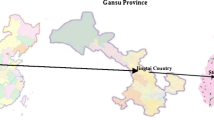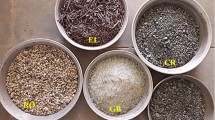Abstract
Suffusion is a typical form of internal erosion for gravel soils in which fine particles are detached by seepage and transport by water through pores. The prediction of erodible particles can improve the assessment of the development of suffusion. The current research on the composition of erodible particles is not sufficiently detailed. The content of erodible particles cannot be accurately determined for a particular gradation. In this paper, a geometric method of generating a particle packing model is proposed. The particles are classified as free or skeleton particles depending on their coordination numbers; thus, their particle size distributions are obtained. Soils with different gradations were analysed using the proposed method. The results indicated that if the grading curve of a soil can be expressed using a fractal relationship, the gradation of free particles also satisfies an exponential function. This is useful in promoting the research on establishing accurate internal erosion criteria, evaluating the performance of filter layers, and predicting the degree of seepage failure caused by internal erosion.





















Similar content being viewed by others
References
Åberg B (1993) Washout of grains from filtered sand and gravel materials. J Geotech Eng 119:36–53. https://doi.org/10.1061/(ASCE)0733-9410(1993)119:1(36)
Andrianatrehina L, Souli H, Rech J et al (2017) Determination of the maximum diameter of free fines to assess the internal stability of coarse granular materials. Eur J Environ Civ Eng 21:332–347. https://doi.org/10.1080/19648189.2015.1116468
Bagi K (2005) An algorithm to generate random dense arrangements for discrete element simulations of granular assemblies. Granular Matter 7:31–43. https://doi.org/10.1007/s10035-004-0187-5
Bi J, Luo X, Shen H, Zhang H (2018) Fractal dimensions of granular materials based on grading curves. J Mater Civ Eng 30:04018083. https://doi.org/10.1061/(ASCE)MT.1943-5533.0002255
Bittelli M, Campbell GS, Flury M (1999) Characterization of particle-size distribution in soils with a fragmentation model. Soil Sci Soc Am J 63:782–788. https://doi.org/10.2136/sssaj1999.634782x
Bonelli S (2012) Erosion of Geomaterials. ISTE, London
Burenkova VV (1993) Assessment of Suffusion in Non-Cohesive and Graded Soils. In: Brauns J, Schuler U, Heibum M (Eds) Proceedings of the 1st International Conference Geo-Filters. Balkema, Karsruhe, Germany, 357–360
Cividini A, Bonomi S, Vignati GC, Gioda G (2009) Seepage-induced erosion in granular soil and consequent settlements. Int J Geomech 9:187–194. https://doi.org/10.1061/(ASCE)1532-3641(2009)9:4(187)
Cui L, O’Sullivan C (2003) Analysis of a triangulation based approach for specimen generation for discrete element simulations. GM 5:135–145. https://doi.org/10.1007/s10035-003-0145-7
Einav I (2007) Breakage mechanics—part I: theory. J Mech Phys Solids 55:1274–1297. https://doi.org/10.1016/j.jmps.2006.11.003
Feng YT, Han K, Owen DRJ (2003) Filling domains with disks: an advancing front approach. Int J Numer Meth Engng 56:699–713. https://doi.org/10.1002/nme.583
Ferrez J-A (2001) Dynamic Triangulations for Efficient 3D Simulation of Granular Materials. Ph.D Thesis, Ecole Polytechnique Federal de Lausanne
Foster M, Fell R, Spannagle M (2000) The statistics of embankment dam failures and accidents. Can Geotech J 37:1000–1024. https://doi.org/10.1139/t00-030
Ghanbarian-Alavijeh B, Millán H, Huang G (2011) A review of fractal, prefractal and pore-solid-fractal models for parameterizing the soil water retention curve. Can J Soil Sci 91:1–14. https://doi.org/10.4141/cjss10008
Han K, Feng YT, Owen DRJ (2005) Sphere packing with a geometric based compression algorithm. Powder Technol 155:33–41. https://doi.org/10.1016/j.powtec.2005.04.055
Indraratna B, Nguyen VT, Rujikiatkamjorn C (2011) Assessing the potential of internal erosion and suffusion of granular soils. J Geotech Geoenviron Eng 137:550–554. https://doi.org/10.1061/(ASCE)GT.1943-5606.0000447
Jentsch H, Salehi Sadaghiani MR, Winkler P, Witt KJ (2014) Experimental investigation – influence of the shape of the gradation curve on the soil structure. In: Cheng L, Draper S, An H (eds) Proceeding of the 7th International Conference on Scour and Erosion. CRC Press, Perth, Australia, pp 105–110
Jentsch H, Winkler P, Salehi Sadaghiani MR et al (2016) Experimental identification of the dominant fabric in widely graded soils. In: Press CRC (ed) Proceeding of the 8th International Conference on Scour and Erosion. Uk, Oxford, pp 439–444
Jerier J-F, Imbault D, Donze F-V, Doremus P (2009) A geometric algorithm based on tetrahedral meshes to generate a dense polydisperse sphere packing. Granular Matter 11:43–52. https://doi.org/10.1007/s10035-008-0116-0
Jiang MJ, Konrad JM, Leroueil S (2003) An efficient technique for generating homogeneous specimens for DEM studies. Comput Geotech 30:579–597. https://doi.org/10.1016/S0266-352X(03)00064-8
Kenney TC, Lau D (1985) Internal Stability of Granular Filters. Can Geotech J 22:215–225. https://doi.org/10.1139/t85-029
Kozak E, Sokołowska Z, Stępniewski W et al (1996) A modified number-based method for estimating fragmentation fractal dimensions of soils. Soil Sci Soc Am J 60:1291–1297. https://doi.org/10.2136/sssaj1996.03615995006000050002x
Kézdi Á (1979) Soil Physics: Selected Topics. Elsevier, Amsterdam
Lei X, Yang Z, He S et al (2017) Numerical investigation of rainfall-induced fines migration and its influences on slope stability. Acta Geotech 12:1431–1446. https://doi.org/10.1007/s11440-017-0600-y
Liu C (2021) Matrix Discrete Element Analysis of Geological and Geotechnical Engineering. Springer Singapore
Martínez-Mena M, Deeks LK, Williams AG (1999) An evaluation of a fragmentation fractal dimension technique to determine soil erodibility. Geoderma 90:87–98. https://doi.org/10.1016/S0016-7061(98)00097-4
Perfect E, Kay BD (1991) Fractal theory applied to soil aggregation. Soil Sci Soc Am J 55:1552–1558. https://doi.org/10.2136/sssaj1991.03615995005500060009x
Perfect E, Rasiah V, Kay BD (1992) Fractal dimensions of soil aggregate-size distributions calculated by number and mass. Soil Sci Soc Am J 56:1407–1409. https://doi.org/10.2136/sssaj1992.03615995005600050012x
Perrier E, Bird N, Rieu M (1999) Generalizing the fractal model of soil structure: the pore—solid fractal approach. Geoderma 88:47–74. https://doi.org/10.1016/S0166-2481(00)80005-7
Salehi Sadaghiani MR, Jentsch H, Faulstich K et al (2014) DEM Modeling and Identification of Representative Element Volume of Soil Skeleton. In: Hicks MA, Brinkgreve RBJ, Rohe A (eds) Proceeding of the 8th European Conference on Numerical Methods in Geotechnical Engineering. CRC Press, Delft, The Netherlands
Salehi Sadaghiani M, Witt KJ, Jentsch H (2012) A Statistical Approach to Identify Mobile Particles of Internally Unstable Granular Soils. Proceeding of the 6th International Conference of Scour and Erosion. France, Paris, pp 132–138
Salehi Sadaghiani MR (2016) Suffusion Phenomenon in Widely Graded Soils - Influence of Homogeneity. Ph.D Thesis, Bauhaus-Universität Weimar
Scholtès L, Hicher P-Y, Sibille L (2010) Multiscale approaches to describe mechanical responses induced by particle removal in granular materials. Comptes Rendus Mécanique 338:627–638. https://doi.org/10.1016/j.crme.2010.10.003
Shire T, O’Sullivan C, Hanley KJ, Fannin RJ (2014) Fabric and effective stress distribution in internally unstable soils. J Geotech Geoenviron Eng 140:04014072. https://doi.org/10.1061/(ASCE)GT.1943-5606.0001184
Skempton AW, Brogan JM (1994) Experiments on piping in sandy gravels. Géotechnique 44:449–460. https://doi.org/10.1680/geot.1994.44.3.449
Sterpi D (2003) Effects of the erosion and transport of fine particles due to seepage flow. Int J Geomech 3:111–122. https://doi.org/10.1061/(ASCE)1532-3641(2003)3:1(111)
Terzaghi K (1943) Theoretical Soil Mechanics. John Wiley & Sons Inc, Hoboken, NJ, USA
Thevanayagam S, Shenthan T, Mohan S, Liang J (2002) Undrained fragility of clean sands, silty sands, and sandy silts. J Geotech Geoenviron Eng 128:849–859. https://doi.org/10.1061/(ASCE)1090-0241(2002)128:10(849)
Thomas PA (1997) Discontinuous deformation analysis of particulate media
To HD, Galindo-Torres SA, Scheuermann A (2016) Sequential sphere packing by trilateration equations. Granular Matter 18:70. https://doi.org/10.1007/s10035-016-0666-5
Turcotte DL (1986) Fractals and fragmentation. J Geophys Res 91:1921. https://doi.org/10.1029/JB091iB02p01921
Turcotte DL (1989) Fractals in geology and geophysics. Pure Appl Geophys 131:26
Tyler SW, Wheatcraft SW (1992) Fractal scaling of soil particle-size distributions: analysis and limitations. Soil Sci Soc Am J 56:362–369. https://doi.org/10.2136/sssaj1992.03615995005600020005x
Wan CF (2006) Experimental Investigation of Piping Erosion and Suffusion of Soils in Embankment Dams and Their Foundations. Ph.D Thesis, University of New South Wales
Winkler P, Jentsch H, Salehi Sadaghiani M, Witt K (2016) Numerical Investigation of the Particle Skeleton of Widely Graded Soils Prone to Suffusion. In: Harris J, Whitehouse R, Moxon S (eds) Proceeding of the 8th International Conference on Scour and Erosion. CRC Press, Oxford, Uk, pp 149–154
Xu Y, Jiang H, Chu F, Liu C (2014) Fractal model for surface erosion of cohesive sediments. Fractals 22:1440006. https://doi.org/10.1142/S0218348X14400064
Xu YF, Sun DA (2002) A fractal model for soil pores and its application to determination of water permeability. Physica A 316:56–64. https://doi.org/10.1016/S0378-4371(02)01331-6
Xu Y, Zhang LM (2009) Breaching Parameters for Earth and Rockfill Dams. J Geotech Geoenviron Eng 135:1957–1970. https://doi.org/10.1061/(ASCE)GT.1943-5606.0000162
Young IM, Crawford JW, Anderson A, McBratney A (1997) Comment on number-size distributions, soil structure, and fractals. Soil Sci Soc Am J 61:1799–1800. https://doi.org/10.2136/sssaj1997.03615995006100060036x
Zhang F, Li M, Peng M et al (2019) Three-dimensional DEM modeling of the stress-strain behavior for the gap-graded soils subjected to internal erosion. Acta Geotech 14:487–503. https://doi.org/10.1007/s11440-018-0655-4
Acknowledgements
This research was supported by the National Dam Safety Research Centre of China (Grant No. CX2019B08) and the National Natural Science Foundation of China (Grant No. 51479112).
Author information
Authors and Affiliations
Corresponding author
Additional information
Publisher's Note
Springer Nature remains neutral with regard to jurisdictional claims in published maps and institutional affiliations.
Rights and permissions
About this article
Cite this article
Bi, J., Zhang, H., Luo, X. et al. Size distribution of free particles in soils: a geometric modelling approach. Acta Geotech. 16, 3849–3866 (2021). https://doi.org/10.1007/s11440-021-01356-w
Received:
Accepted:
Published:
Issue Date:
DOI: https://doi.org/10.1007/s11440-021-01356-w




